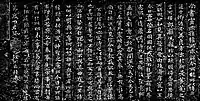Regular script
Regular script (traditional Chinese: 楷書; simplified Chinese: 楷书; pinyin: kǎishū; Hepburn: kaisho), also called 正楷 (pinyin: zhèngkǎi), 真書 (zhēnshū), 楷體 (kǎitǐ) and 正書 (zhèngshū), is the newest of the Chinese script styles (popularized from the Cao Wei dynasty c. 200 AD and maturing stylistically around the 7th century). It is the most common style in modern writings and third most common in publications (after the Ming and gothic styles, which are used exclusively in print).
| Regular script | |
|---|---|
 | |
| Script type | |
Time period | Bronze Age China, Iron Age China, Present day |
| Languages | Old Chinese, Middle Chinese, Modern Chinese |
| Related scripts | |
Parent systems | Oracle bone script
|
Child systems | Traditional Chinese Simplified Chinese Bopomofo Kanji Kana Hanja Chữ Hán Chữ Nôm Khitan large script Khitan small script Jurchen script Tangut script Nü Shu |
| Unicode | |
Unicode range | 4E00–9FFF, 3400–4DBF, 20000–2A6DF, 2A700–2B734, 2F00–2FDF, F900–FAFF |
| Regular script | |||||||||||||||||
|---|---|---|---|---|---|---|---|---|---|---|---|---|---|---|---|---|---|
 Chinese characters of "Regular Script" in traditional characters (left) and in the simplified form (right). | |||||||||||||||||
| Chinese name | |||||||||||||||||
| Traditional Chinese | 楷書 | ||||||||||||||||
| Simplified Chinese | 楷书 | ||||||||||||||||
| Literal meaning | model script | ||||||||||||||||
| |||||||||||||||||
| Alternative Chinese name | |||||||||||||||||
| Traditional Chinese | 真書 | ||||||||||||||||
| Simplified Chinese | 真书 | ||||||||||||||||
| Literal meaning | real script | ||||||||||||||||
| |||||||||||||||||
| Second alternative Chinese name | |||||||||||||||||
| Chinese | 正楷 | ||||||||||||||||
| Literal meaning | correct model | ||||||||||||||||
| |||||||||||||||||
| Third alternative Chinese name | |||||||||||||||||
| Traditional Chinese | 楷體 | ||||||||||||||||
| Simplified Chinese | 楷体 | ||||||||||||||||
| Literal meaning | model form | ||||||||||||||||
| |||||||||||||||||
| Fourth alternative Chinese name | |||||||||||||||||
| Traditional Chinese | 正書 | ||||||||||||||||
| Simplified Chinese | 正书 | ||||||||||||||||
| Literal meaning | correct script | ||||||||||||||||
| |||||||||||||||||
| Japanese name | |||||||||||||||||
| Kanji | 楷書 | ||||||||||||||||
| Hiragana | かいしょ | ||||||||||||||||
| |||||||||||||||||
History


其數然而天地苞
乎陰陽而易識者
以其有象也陰陽
處乎天地而難窮
The Calligraphy Manual of Xuanhe Era (宣和書譜; Xuānhé Shūpǔ) credit Wáng Cìzhòng (王次仲) with creating Regular script based on Clerical script in the early Western Hàn. This script came into popular usage between the Eastern Hàn and Cáo Wèi dynasties,[1] and its first known master was Zhōng Yáo (鍾繇; sometimes also read Zhōng Yóu),[2] who lived in the Eastern Hàn to Cáo Wèi period, c. 151–230 CE. He is also known as the "father of regular script", and his famous works include the Xuānshì Biǎo (宣示表), Jiànjìzhí Biǎo (薦季直表), and Lìmìng Biǎo (力命表). Qiu Xigui[1] describes the script in Zhong's Xuānshì Biǎo as:
...clearly emerging from the womb of early period semi-cursive script. If one were to write the tidily written variety of early period semi-cursive script in a more dignified fashion and were to use consistently the pause technique (dùn 頓, used to reinforce the beginning or ending of a stroke) when ending horizontal strokes, a practice which already appears in early period semi-cursive script, and further were to make use of right-falling strokes with thick feet, the result would be a style of calligraphy like that in the "Xuān shì biǎo".
However, other than a few literati, very few wrote in this script at the time; most continued writing in neo-clerical script, or a hybrid form of semi-cursive and neo-clerical.[1] Regular script did not become dominant until the early Southern and Northern Dynasties, in the 5th century; there was a variety of regular script which emerged from neo-clerical as well as from Zhong Yao's regular script,[3] known as "Wei regular" (魏楷, Wèikǎi) or "Wei stele" (魏碑, Wèibēi). Thus, regular script has parentage in early semi-cursive as well as neo-clerical scripts.
The script is considered to have matured stylistically during the Tang dynasty, with the most famous and oft-imitated regular script calligraphers of that period being:
- Four great calligraphers of the early Tang (初唐四大家):
- Ouyang Xun (歐陽詢)
- Yu Shinan (虞世南)
- Chu Suiliang (褚遂良)
- Xue Ji (薛稷)
- "Yan–Liu" ("顏柳")
- Yan Zhenqing (顏真卿)
- Liu Gongquan (柳公權)
In the Northern Song dynasty, Emperor Huizong created an iconic style known as "Slender Gold" (瘦金體).
In the Yuan dynasty, Zhao Mengfu is also known for his own calligraphic style for regular script, "Zhaoti" (趙體).
In the Qing dynasty, the ninety-two rules for the fundamental structure of regular script are established, calligrapher Huang Ziyuan wrote a guidebook to illustrate these rules, each rule has four characters for sample.
Name
In addition to its many names in Chinese, regular script is also sometimes called "block script",[4] "standard script"[5] (alternate translation of 楷) or even "square style"[6] in English.
Characteristics
Regular script characters with width (or length) larger than 5 cm (2 in) is usually considered larger regular script, or dakai (大楷), and those smaller than 2 cm (0.8 in) usually small regular script, or xiaokai (小楷). Those in between are usually called medium regular script, or zhongkai (中楷). What these are relative to other characters. The Eight Principles of Yong are said to contain a variety of most of the strokes found in regular script.
Notable writings in regular script include:
- The Records of Yao Boduo Sculpturing (姚伯多造像記) during the Southern and Northern dynasties
- The Tablet of Guangwu General (廣武將軍碑) during the Southern and Northern dynasties
- The Tablet of Longzang Temple (龍藏寺碑) of the Sui dynasty
- Tombstone-Record of Sui Xiaoci (蘇孝慈墓誌) of the Sui dynasty
- Tombstone-Record of Beauty Tong (董美人墓誌) of the Sui dynasty
- Sweet Spring at Jiucheng Palace (九成宮醴泉銘) of the Tang dynasty
Derivatives
- Imitation Song typefaces (Chinese: 仿宋體; pinyin: fǎng Sòngtǐ) are typefaces based on a printed style which developed in the Song dynasty, from which Ming typefaces developed.
- The most common printed typeface styles Ming and sans-serif are based on the structure of regular script.
- The Japanese textbook typefaces (教科書体; Hepburn: kyōkashotai) are based on regular script, but modified so that they appear to be written with a pencil or pen. They also follow the standardized character forms prescribed in the Jōyō kanji.
- Zhuyin Fuhao characters, although not true Chinese characters, are virtually always written with regular script strokes.
References
Citations
- Qiú 2000 p. 143
- Qiú 2000 p. 142
- Qiú 2000 p. 146
- Gao, James Z. (2009), Historical Dictionary of Modern China (1800-1949), Scarecrow Press, p. 41.
- "5 script styles in Chinese Calligraphy".
- "Meaning of しんしょ in Japanese | RomajiDesu Japanese dictionary".
Sources
- Qiu Xigui (2000). Chinese Writing. Translation of 文字學概論 by Mattos and Norman. Early China Special Monograph Series No. 4. Berkeley: The Society for the Study of Early China and the Institute of East Asian Studies, University of California, Berkeley. ISBN 1-55729-071-7.
External links
- Regular Script "tao te king" CHAPTER LVII
- More on Standard Script In English, at BeyondCalligraphy.com